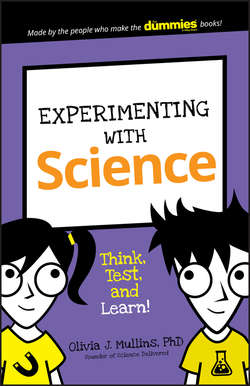Читать книгу Experimenting with Science - Mullins Olivia J. - Страница 2
На сайте Литреса книга снята с продажи.
INTRODUCTION
ОглавлениеWELCOME TO EXPERIMENTING WITH SCIENCE. I am so excited to guide you in your scientific journey as you test, explore, learn, have fun, and, yes, experiment. My goal is for you to experience the thrill of scientific discovery.
SO WHAT IS SCIENCE? Science is the study of the world around you – or even the world inside of you. In this book, you learn about many scientific disciplines, so get ready to make some reactions, trick your brain, harness magnetic forces, combine science and art, and more!
ABOUT SCIENTISTS
Scientists are so diverse it’s hard to know how to describe them. In research laboratories (where scientists work), you will find men and women, young and old, from countries all over the world. But all scientists have one thing in common: They love learning and have a big curiosity about how the world works.
The job of a scientist is to discover new things, and they study all sorts of different stuff. Some scientists study how to cure diseases in hopes of helping people stay healthy. Some study gigantic collapsing stars, while others study the behavior of tiny ants. For some scientists, it’s normal to scuba dive around the ocean taking video of elusive sea creatures. It’s safe to say that scientists have pretty cool jobs.
If you’re a person who is curious about the world, you may consider being a scientist when you grow up.
ABOUT THIS BOOK
This book is filled with fun and enlightening science experiments. The experiments are split up into seven chapters, and each chapter starts with a quick introduction and a section about the science behind the experiments (with the exception of the final chapter). The best thing to do is to read this science overview before starting the experiments within the chapter. Don’t worry if you don’t understand everything at once. Learning about science is a process that can take time.
Each chapter contains several experiments. You don’t have to do the experiments in order or even do all of them, although sometimes it may be helpful to complete some of the earlier, simpler experiments first.
Each experiment starts with a brief description of what you will be doing and a supply list. Make sure that you have all the supplies you need before you get started. (You can find most supplies around the house or at a grocery store. A few experiments have slightly more specialized supplies that you may need to order.) You can find a master supply list at www.dummies.com/go/experimentingwithscience.
You can then follow the instructions to start your project. While you’re working, make sure that you make observations of what you see, hear, feel, or even smell! I encourage you to make predictions of what you think will happen in your experiment. If you want to keep track of your predictions and data, go online to www.dummies.com/go/experimentingwithscience to find guidelines for making your own lab notebook.
When you complete your experiment, read about the science at the end of each project. This information helps you understand what you just observed. Some of these concepts are pretty crazy! See whether the explanations are consistent with your observations and experimental results.
At the end of each experiment is a section that tells you how you can take the experiment further. This is a very important section! Science is all about curiosity and discovery. You can usually do an experiment in more than one way, and you can expand on the experiments presented in the book in a lot of ways. I encourage you to use the projects and instructions outlined in the book as a starting point and then go wild. Follow your curiosity and don’t be limited by the steps on the page.
As you go through the book, some experiments will work immediately, but some may take a couple tries. Don’t worry if you have to try the experiment a few times. It turns out that every scientist has had many experiments that don’t work. In fact, you often learn just as much, or more, from what goes wrong as you learn from what goes right. But you learn the most when you’re enjoying what you do, so start experimenting and have a blast!
SAFETY
Safety is a very important part of science. Do not eat or drink your experiments. Do not rub your eyes if you have chemicals on your hands. Something like lemon juice is mostly safe, but it will sting a whole lot if you get it in your eyes! Pay attention to any safety warnings I have on the experiments and wear gloves and eye protection when necessary.
ABOUT YOU
You are a wonderful, bright, and curious kid. Maybe you already love science, or maybe you aren’t so sure if you like it. Maybe school is easy for you, or maybe sometimes it‘s really tough! Either way, science is for all kids, and the experiments in this book are for you.
WHAT YOU NEED TO KNOW
One thing you need to know for many experiments in this book is how to make measurements. If you’re unsure how to measure out things like 8 inches or ½ tablespoon, it’s no problem – just find an adult to help you out with this part.
ABOUT THE ICONS
As you read through the projects in this book, you’ll see a few icons. The icons point out different things:
This icon points out tips that can make your experiments run more smoothly.
This icon alerts you to information that you’ll want to remember.
Pay attention to the warnings! They contain safety information or instructions on how to perform an experiment without damaging anything in your house (like keeping magnets away from computers). Some warnings are used to prevent something that may ruin the actual experiment.
